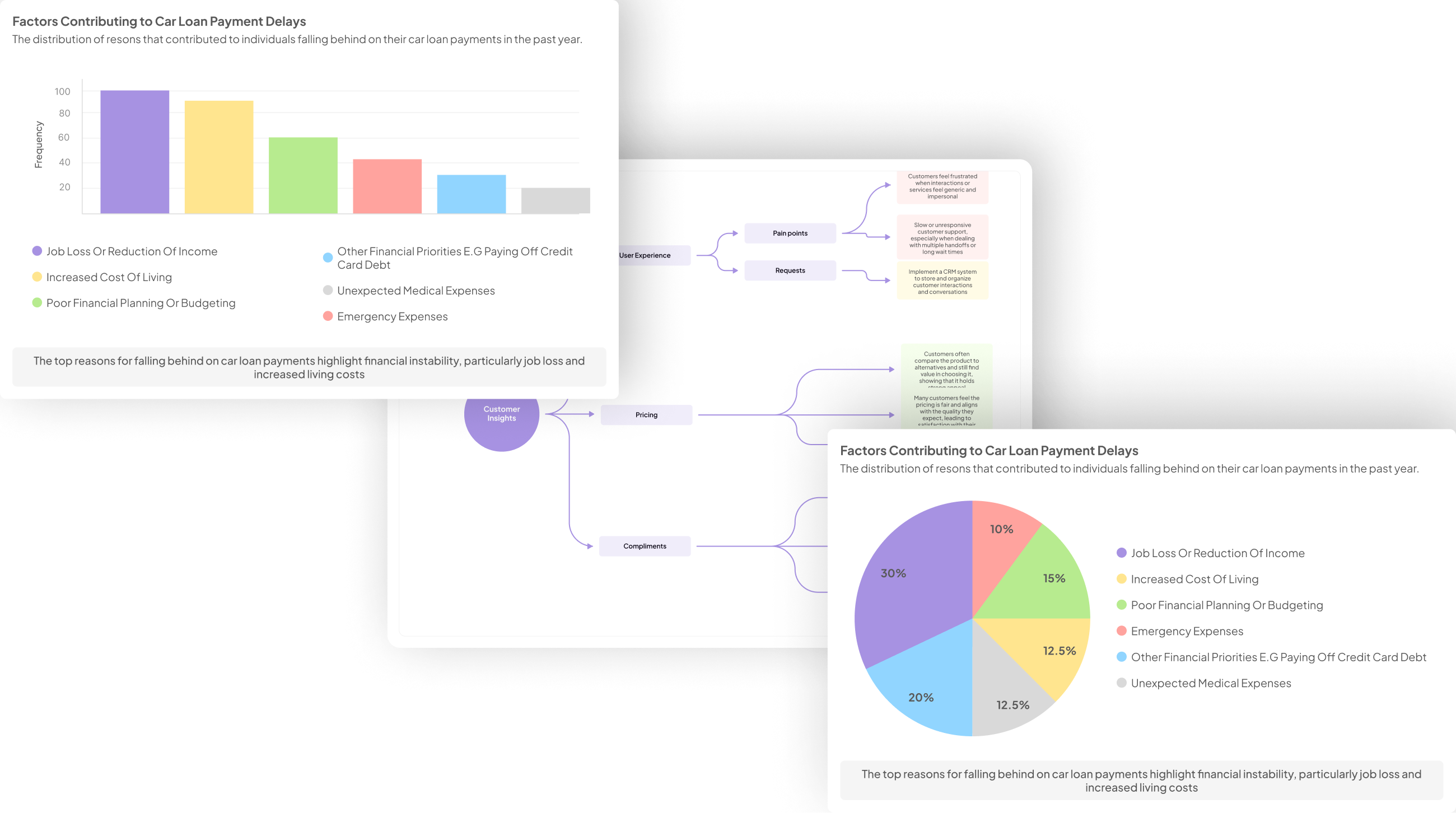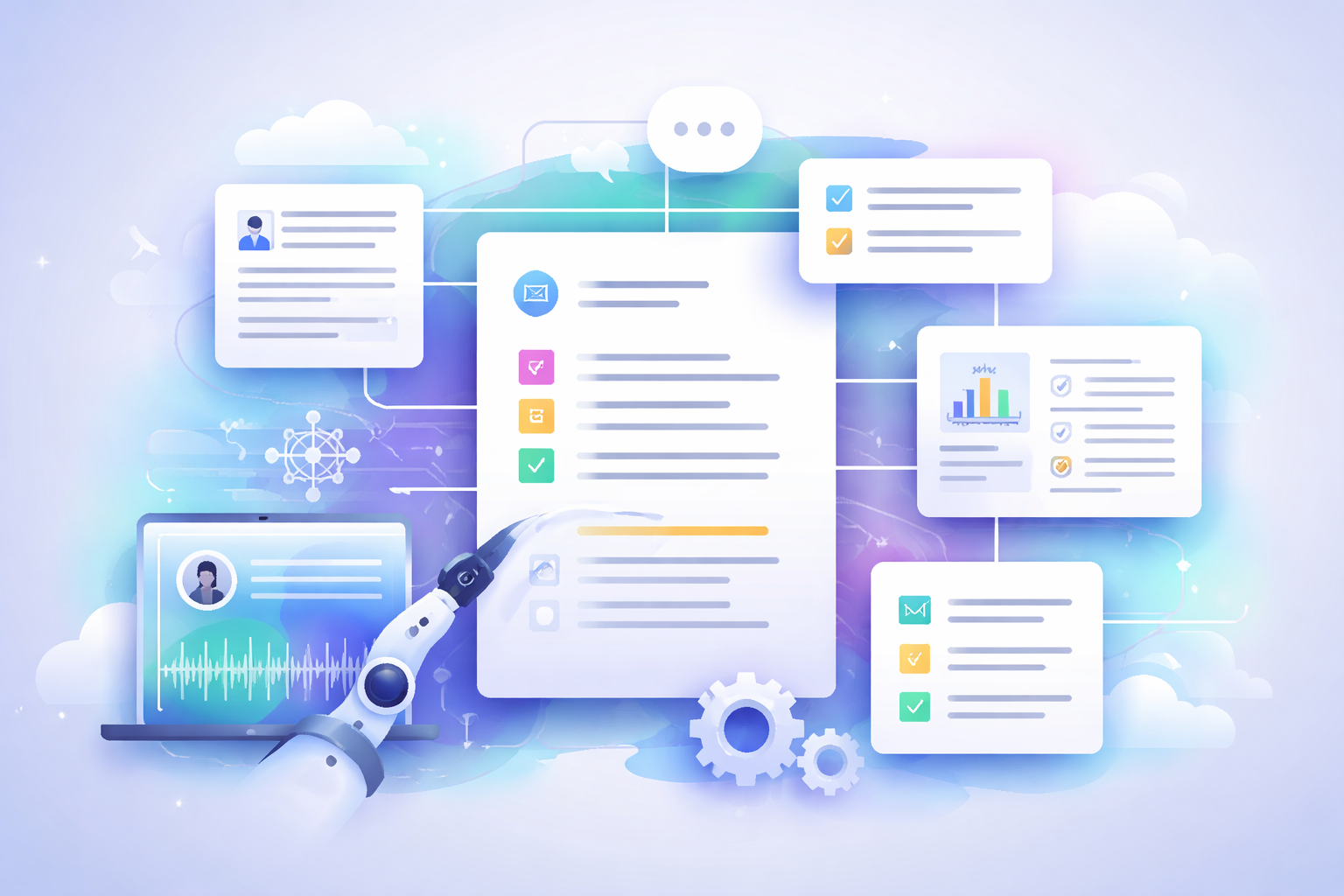Best AI tools for analyzing themes from consumer interviews
-
Bella Williams
- 10 min read
Understanding consumer motivations is a crucial element of business success. However, achieving clarity from a large volume of consumer interviews can be quite daunting. This is where Consumer Interview Analysis comes into play, revealing valuable themes that can inform strategic decisions and enhance customer engagement.
AI tools have emerged as powerful allies in this domain, streamlining the analysis process and providing deeper insights. By automating the identification of trends and sentiments from interviews, these tools allow businesses to focus on implementation rather than data gathering alone. As companies generate more customer insights than ever, employing advanced analytics can transform how they connect with their audience and respond to their needs.
Generate visualizations from your qualitative data. At Scale.

Importance of Consumer Interview Analysis in Modern Business
Consumer Interview Analysis plays a crucial role in modern business strategies. By understanding consumers’ perspectives and experiences, businesses can identify key themes that inform product development and marketing strategies. In an era where rapid feedback loops and agile responses are essential, companies that effectively analyze consumer interviews gain a competitive edge. The insights derived from these interviews empower organizations to adapt quickly to changing market demands and preferences.
Moreover, efficient consumer interview analysis can streamline decision-making processes, making them more data-driven. With advancements in AI tools, businesses can automate and augment the analysis of qualitative feedback, transforming vast amounts of subjective data into actionable strategies. These AI solutions not only enhance speed and accuracy but also help in uncovering hidden patterns that might go unnoticed through traditional methods. Ultimately, thorough consumer interview analysis is vital for fostering innovative solutions and building stronger customer relationships.
Best AI Tools for Consumer Interview Analysis
To effectively enhance consumer interview analysis, using the right AI tools can transform how businesses extract insights from their data. AI tools simplify the task of identifying themes and patterns in consumer conversations, enabling companies to respond faster and more efficiently. Traditional methods of analysis often become cumbersome and slow, leading to missed opportunities. By leveraging AI, organizations can quickly uncover actionable insights that keep them ahead of the competition.
Among the leading AI tools available for consumer interview analysis, several stand out due to their unique features. For example, MonkeyLearn excels in text analysis, providing users with keyword extraction and sentiment analysis capabilities. Quirkos offers a user-friendly interface for qualitative analysis, allowing for easy theme identification. Nvivo stands out for its robust data management features, making it ideal for handling large datasets. Lastly, Dovetail focuses on collaboration, ensuring team members can share insights seamlessly. Using these tools effectively streamlines the analysis process, transforming overwhelming information into clear, actionable strategies.
Evaluate Performance on Customer Calls for Quality Assurance.
Insight7: Your Primary Companion
The journey of Consumer Interview Analysis transforms when you have a reliable companion like Insight7. Think of it as having a dedicated partner that helps untangle the complexities of customer conversations. By utilizing AI-driven technology, it streamlines the data analysis process, enabling businesses to gain insights effortlessly. This platform is designed for ease of use, making it accessible to professionals who may not have extensive expertise in data analysis.
With Insight7, you can efficiently decode customer signals and thematic patterns from interviews, helping you stay ahead in a competitive market. Instead of sifting through mountains of raw data manually, the platform automates the tedious aspects, allowing you to focus on crafting actionable outcomes. As you engage with consumer insights, Insight7 ensures that your analysis is timely and relevant, strengthening the foundations of your business strategies.
Other Leading AI Tools for Analyzing Consumer Interview Themes
Various AI tools stand out in the competitive arena of consumer interview analysis, each offering unique features tailored to deciphering complex themes. Among these, MonkeyLearn excels in its user-friendly text analysis capabilities, allowing teams to easily categorize and understand large datasets. Quirkos, on the other hand, provides an intuitive visual interface that helps users quickly identify patterns in qualitative data, making it a favorite for those who prefer a more exploratory approach.
Nvivo is particularly invaluable for academic and professional researchers, as it supports a comprehensive analysis of both qualitative and quantitative data. Within the realm of collaboration, Dovetail shines, streamlining the way teams share insights and integrate findings from multiple interviews. These tools collectively enhance the ability to transform raw interview data into actionable strategies, ultimately driving business success through informed decision-making.
- MonkeyLearn
In the realm of consumer interview analysis, one effective tool stands out due to its user-friendly design and powerful analytics capabilities. This platform allows teams to process vast amounts of interview data quickly and efficiently. Customers can easily create custom models to sift through feedback, identifying trends and themes that would otherwise remain hidden. Utilizing advanced natural language processing, users gain deeper insights into consumer sentiments and opinions.
The real strength of this tool lies in its versatility. Whether you're conducting qualitative research or gathering quantitative feedback, it adapts to various data types and formats. By implementing this tool, businesses can streamline their analysis processes, allowing for quicker decision-making based on solid consumer insights. With this approach, companies can enhance their strategies and improve their offerings, ultimately leading to greater customer satisfaction and engagement.
- Quirkos
In the realm of consumer interview analysis, effective tools are crucial for transforming raw insights into actionable strategies. Quirkos stands out for its intuitive interface and visual approach, making it easier to identify and categorize themes from consumer conversations. This platform allows users to consolidate their findings, streamlining the process of analyzing interviews at scale.
Quirkos operates on the principle that understanding consumer sentiments can significantly enhance business performance. It provides a visual workspace where users can drag and drop text segments into different themes, ensuring a more organized analysis. This simplicity fosters collaboration among team members, allowing for a richer understanding of customer insights. Ultimately, adoption of such innovative tools empowers businesses to respond more swiftly to consumer needs, enhancing engagement and satisfaction.
- Nvivo
Nvivo serves as an essential tool for Consumer Interview Analysis by allowing researchers to excavate rich insights from qualitative data. It enables users to efficiently organize and analyze interview content, facilitating the identification of recurring themes and patterns. With remarkable versatility, this software caters to various data types, including text, audio, and video, making it a valuable resource for comprehensive analysis.
The tool supports a systematic coding approach, which allows users to tag segments of data and categorize them under relevant themes. This coding process aids in isolating important trends that emerge during consumer interviews, ensuring a robust understanding of customer sentiments and behaviors. By employing Nvivo, teams can not only uncover actionable insights but also enhance the overall quality of their analysis, leading to informed decision-making and strategic improvements across business operations.
- Dovetail
Dovetail serves as a vital resource in the realm of consumer interview analysis, enabling businesses to extract meaningful insights from vast amounts of qualitative data. It simplifies the process of analyzing interviews, transforming what once was a laborious task into an efficient and structured operation. With advanced tagging capabilities and intuitive interface design, Dovetail assists teams in identifying themes and connecting different pieces of information seamlessly.
Utilizing Dovetail encourages collaboration, allowing teams to share insights easily and incorporate various perspectives into the analysis process. The system's capabilities streamline communication, ensuring that valuable consumer signals do not remain lost in emails or scattered files. By implementing Dovetail, organizations can convert raw data from consumer interviews into actionable strategies, ultimately positioning themselves ahead of the competition in understanding consumer needs. This tool not only enhances efficiency but also enriches the overall analysis, making it an indispensable part of modern business strategy.
Steps to Implement AI Tools in Consumer Interview Analysis
Implementing AI tools in consumer interview analysis involves a systematic approach to maximize insights from data. Start by gathering and preparing your interview data. This involves transcribing audio recordings and organizing notes to ensure the information is structured for analysis. The quality of data significantly influences the outcomes, so be meticulous during this step.
Next, selecting the right AI tool is crucial. Research options like MonkeyLearn or Nvivo, understanding their features and how they align with your analysis goals. After choosing a suitable tool, dive into analyzing themes. Use the AI tool to identify patterns, sentiments, and emerging topics within your interview data. This step converts raw data into actionable insights, allowing businesses to refine their strategies and better serve customers. By following these steps, organizations can enhance their consumer interview analysis, driving more informed decision-making.
Step 1: Gathering and Preparing Interview Data
Gathering and preparing interview data is the foundation for effective consumer interview analysis. First, collect all relevant interview materials, including audio recordings, transcripts, and any notes taken during the interviews. Ensure this data is organized in a manageable format that facilitates easy access during analysis. This preliminary step is crucial, as well-structured data will contribute significantly to the quality of your insights.
Next, standardize your data by including essential metrics or evaluation criteria that align with your research objectives. By setting clear benchmarks for what you're analyzing, you create a framework that guides the subsequent analysis process. This preparation not only clarifies your goals but also helps identify key themes emerging from the interviews. Following these steps will enhance the effectiveness of the AI tools you choose for further analysis, ensuring that the insights you derive are actionable and valuable.
Step 2: Selecting the Right AI Tool
Selecting the right AI tool is crucial for effective consumer interview analysis. The ideal tool should align with your specific needs, such as ease of use, analytical capabilities, and integration options. Start by evaluating your objectives: do you need advanced sentiment analysis, or are you focused on qualitative coding? Prioritize tools that provide features tailored to your goals; this clarity helps streamline the analysis process.
Next, consider scalability and cost. You want an AI solution that can grow with your needs without breaking your budget. Look for user-friendly platforms that offer trial versions, allowing you to test functionalities before committing. Finally, ensure strong customer support and community resources; these aspects are vital when navigating the complexities of consumer interview analysis. A well-chosen AI tool enhances your ability to distill insights, ultimately contributing to data-driven decision-making in your business.
Step 3: Analyzing Themes with AI Tools
Analyzing themes with AI tools is a crucial step in consumer interview analysis. Leveraging AI technology helps identify patterns and insights from large volumes of qualitative data quickly and efficiently. By utilizing sentiment analysis and natural language processing, AI can sift through interview transcripts to extract key themes and highlight significant trends. This analytical process not only accelerates data interpretation but also enhances the accuracy of findings.
To effectively analyze themes, follow these steps: First, consolidate your interview data into a manageable format. Next, utilize an AI tool that specializes in qualitative analysis. Most tools will allow you to categorize responses and summarize key insights automatically. Additionally, many platforms provide visual dashboards to showcase themes and their frequency among interviewees. This visualization helps stakeholders easily grasp the main takeaways and make informed decisions based on comprehensive consumer feedback.
Conclusion on the Power of AI in Consumer Interview Analysis
The integration of AI into consumer interview analysis marks a transformative shift in how businesses understand their customers. By automating the analysis of rich qualitative data, companies can sift through enormous volumes of information quickly. This efficiency allows for timely identification of critical insights, enabling organizations to respond effectively to consumer needs.
Moreover, AI tools significantly enhance collaboration among teams. With insights neatly organized and easily shareable, businesses can drive discussions and collective decision-making more efficiently. Ultimately, adopting AI for consumer interview analysis not only streamlines the process but also empowers companies to turn customer voices into actionable strategies that foster growth and competitive advantage.
Generate visualizations from your qualitative data. At Scale.








